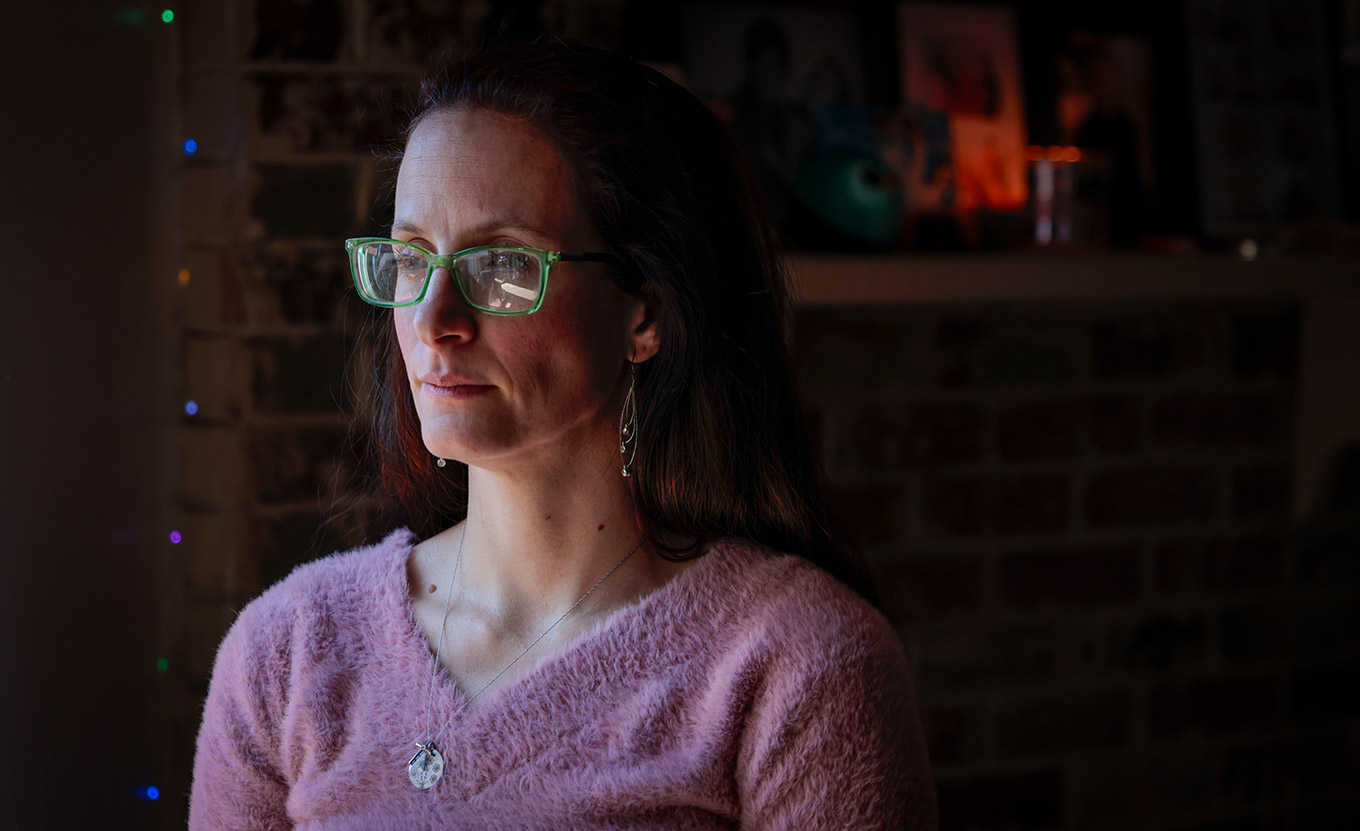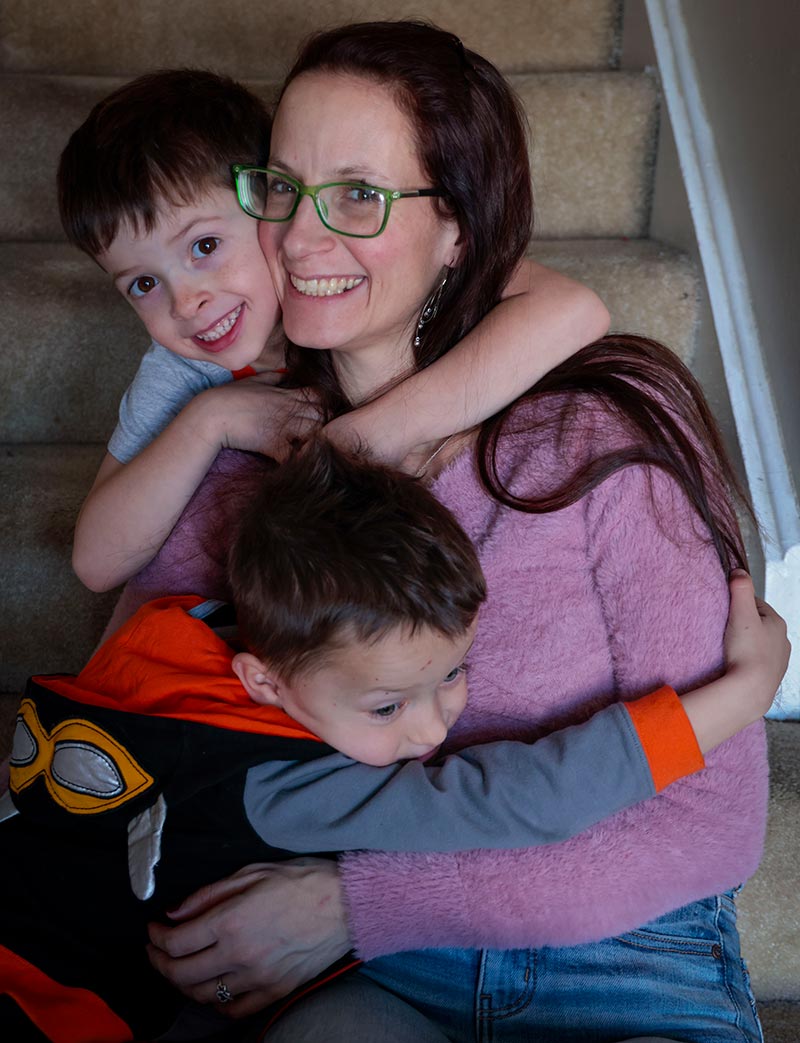
Ashley Miller, photographed in Denver on Feb. 4, 2024. Photo by Joe Mahoney / Special to The Colorado Trust
Ashley Miller, photographed in Denver on Feb. 4, 2024. Photo by Joe Mahoney / Special to The Colorado Trust
In early 2018, just seven weeks after she delivered her twins, Ashley Miller relapsed and started using methamphetamine again.
The relapse came after a traumatic cesarean birth, during which one of her twins had to be resuscitated, and after returning to a relationship with a man who also had a substance use disorder.
She used methamphetamine for about a month and tried to get back into treatment. She bounced around to a few places but eventually returned home to Colorado Springs, where she overdosed on heroin in a hotel room.
A family member called child welfare, which removed Miller’s twins from her care.
“When they came and took my kids, I really didn’t feel anything. I was high,” Miller said. “And to be honest with you, I needed help. I needed something.
“I was living in a hotel. We were doing drugs. That’s not where I was supposed to be. That’s not what I wanted. That’s not what I deserved.”
When Miller’s children were removed from her care, she reconnected with Aspen Miracle Center in Westminster, Colo., where she had received treatment during her pregnancy. Aspen readmitted her into its program.
Aspen Miracle Center is an inpatient treatment facility in Westminster for Medicaid patients with around-the-clock staffing. Miller could guarantee to her El Paso County Child Protective Services social worker that a staff member would always be present to watch over her twins. She was reunited with them five days after they were removed from her care. At Aspen Miracle Center, with her twins present, she detoxed and started working toward sobriety once again.
“I haven’t stopped since,” Miller said. “I’ve been working just as hard—as soon as I woke up from withdrawal or recovering from being up for however many days—I’ve just been working ever since.”
Miller’s story contrasts with those of many pregnant and postpartum people in Colorado and nationwide. In Colorado, from 2016 to 2020, the second leading cause of death for pregnant and postpartum people was accidental overdose, according to a July 2023 report from the Colorado Maternal Mortality Review Committee. (The leading cause of death for this demographic during the same period was suicide.) There were 174 pregnancy-associated deaths during the four years, making Colorado’s pregnancy-associated mortality ratio 54.7 deaths per 100,000 live births.
Nationally, the maternal mortality rate has been steadily increasing. In 2021, the rate was 32.9 deaths per 100,000 live births.
Because of different methodologies, it is difficult to compare the state and national rates. The maternal mortality rate in Colorado is calculated over a period that includes pregnancy and the first year after giving birth. Colorado’s data also include deaths that are both pregnancy-associated as well as pregnancy-related, which means all deaths that occur during pregnancy or within one year of the end of pregnancy are included.
By contrast, the National Center for Health Statistics only looks at deaths during pregnancy and through six weeks postpartum. It does not include deaths “from accidental or incidental causes,” which excludes deaths from causes such as accidental overdose.
Maternal mortality is often considered a metric of the overall health of a community. While state and national rates cannot be easily compared, one thing is clear: the rate of maternal mortality is increasing nationwide, putting birthing people at a higher risk of death.
In Colorado and the rest of the country, people of color, people living in poverty or rural areas, those with less than a high school education or people who are older than 40 are disproportionately impacted by maternal mortality. Addressing the high mortality rates among these populations is an essential step toward achieving health equity, according to the Maternal Mortality Review Committee report.
Over the last decade, in particular, Colorado hospitals, lawmakers and community organizations have worked to address the increasing maternal mortality rate due to mental and behavioral health issues, including overdose. These changes have had a positive impact, but those same changemakers point to many improvements that still need to be made.
For most of the 20th century, maternal mortality dropped rapidly across the world. The introduction of improved maternity services, safer surgical procedures and antibiotics, to name a few factors, led to better outcomes for pregnant and postpartum people.
In 1933, the ratio of deaths to live births in the U.S. was 619 per 100,000, according to The Commonwealth Fund. The number decreased through the 1960s to 37 per 100,000, then even more to about nine deaths per 100,000 in the 1990s.
Then, in 1997, the trend started to move in the opposite direction in the U.S. By 2017, maternal mortality was continuing to decline worldwide except in two countries: the U.S. and the Dominican Republic, according to the World Health Organization. The 2021 ratio of deaths to live births in this country is nearing the ratio last seen more than 60 years ago.
Between 2007 and 2016, the leading causes of death for pregnant and postpartum people included infection, severe bleeding and heart conditions. In 2016, that all started to change: two of the leading causes of death are now related to mental or behavioral health, including suicide and accidental overdose related to a substance use disorder.
“As an obstetric provider, it was shocking to me that it’s actually behavioral health care issues like substance use and anxiety and depression,” said Amber Johnson, a certified nurse midwife and quality improvement coach at the Colorado Perinatal Care Quality Collaborative. “For me, and I think for many clinicians, that’s kind of a pivotal point of us just realizing that it’s not the things that we were classically trained in as obstetric providers, like hemorrhage and hypertension and infection.”
Training obstetric providers is one step toward creating better outcomes for birthing patients with substance use disorders. The Maternal Overdose Matters Plus program was launched in 10 birthing hospitals earlier this year. The program aids hospitals in providing equitable access to treatment and recovery for patients with substance use disorders, as well as offers birthing hospitals free naloxone, a life-saving overdose medication, to dispense to families where the pregnant person or someone else in the household is at risk of opioid overdose.
The initiative allows providers to start medication-assisted treatment (such as the use of buprenorphine or methadone to treat opioid use disorder) while pregnant patients are at the hospital for delivery or another reason. This moves away from the older model of providing patients with a list of self-guided resources and takes advantage of critical windows of care to get patients on a treatment plan.
For Miller, an earlier intervention might have changed the trajectory of her addiction well before she gave birth to her twins. She started using methamphetamine in 2009 when she was 22 years old. She was already the mother of two young boys—the first she had when she was 16 and living in a group home, and the second when she was 19. Today, both boys live with their fathers.
Miller’s mom struggled with substance abuse when she was growing up. Her interest in trying meth for the first time was related to her mother’s use of it.
“I just wanted to know more about it. I was so curious as to why my mom chose that over me,” she said.
Miller continued to raise her first two children while her meth use persisted.
“I still picked up my kids from school. I was part of the PTO. I would use it more like a tool,” she said. “That doesn’t mean that I also didn’t spend a lot of time in the bathroom—I spent a lot of time in the bathroom. My kids may have been neglected, not sure, but I was still there, and they were there.”
She got married and pregnant again with her third son when she was 25. (The twins are her fourth and fifth sons.) She managed to stay sober during her pregnancy but relapsed soon after giving birth. Something flipped for her. She called it a quarter-life crisis.
“I started thinking, why did that happen with my parents? Why was I in the system? Why did my mom do drugs? Why was my dad violent?” Miller wondered.
“I was shattered. I was a fractured person. Looking back now, I was probably coping with these things with the tools that I had at my disposal.”
She left her partner when her third son was about eight months old.
“My life spiraled. I was living with this boyfriend. I was running away from him all the time because he was controlling everybody around him with heroin. … I would always have to go back because he was a heroin drug dealer, so he always had it,” Miller said. “When I got on heroin, that’s when I had nothing.” While using meth, she said, “I was still scheduled, still had my kids—but heroin, before I knew it, five years was gone. It was crazy.”
A stint in jail for possession and theft landed her in court-mandated treatment, which she said was necessary because she learned a lot and started to understand her addiction better. However, she had to leave the treatment center after attempting suicide; the center said it didn’t have suitable mental health treatment options for her.
She managed to stay sober for more than a year. Then, she became pregnant with her twins. She relapsed after finding out, and about halfway through her pregnancy, she found Aspen Miracle Center.
During the time Miller was using, then getting clean and then relapsing, overdose deaths in Colorado and the U.S. were steadily climbing. Between 2019 and 2021, overdose deaths increased by more than 70%, according to state and federal data, and Colorado’s overdose deaths outpaced the national average.
For Miller, who now lives and works in Denver, where she has custody of her twins, the difference has been her time at the Aspen Miracle Center. She met people she could relate to and rely on and who understood what she was going through. She learned the skills she needed to choose her children over her relationship with her ex-boyfriend and other people in her life who use substances. Miller said she also started figuring out how to break the generational cycle she was born into.
“I grew up with my dad,” she said. “My mom was on substances. My children grew up with their dads, and I did substances. So I followed out that generational pattern, and I get to choose to do something different with my younger kids today.”

Miller’s twins, Elias and Osias, are now 6 years old. Photo by Joe Mahoney / Special to The Colorado Trust
Part 2 in series: Colorado Changed its Definition of Child Abuse and Introduced “Plans of Safe Care.” The Impact isn’t Clear.
Part 3 in series: Inpatient Substance Treatment Centers Can Be Life-Saving for Pregnant People, but There Aren’t Enough Facilities